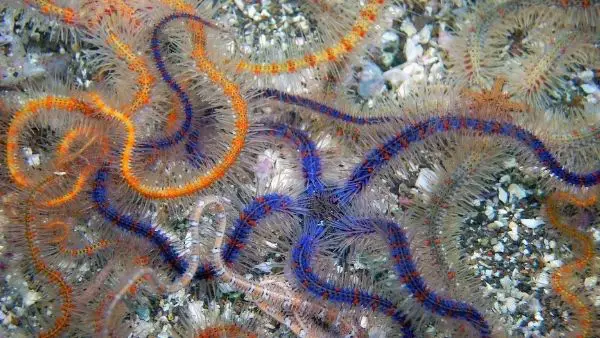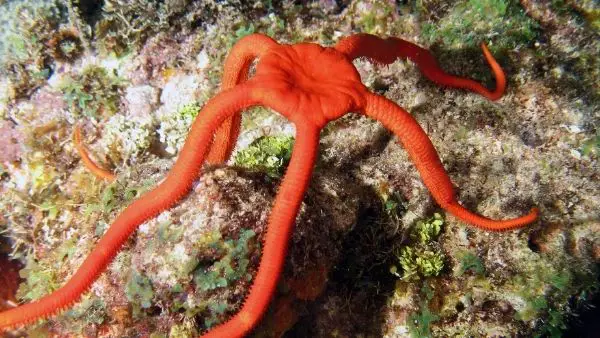Discovering something in your aquarium that you perhaps didn't introduce or even know about is a strange experience. Fortunately, or unfortunately - whichever way you look at it, it is a pretty common occurrence and will certainly happen during your journey as a fish keeping hobbyist.
What you must do if you uncover a critter residing in your tank is identify it immediately. Once you have identified it, you can find out whether or not they will either do damage to your aquarium and community or bring many benefits to your tank, fish, reef, and more.

In this article we are focusing on the Mini Brittle Stars - which are good critters, meaning that you needn't worry if you discover one of these without an invitation. In fact, they will bring a multitude of benefits to your community. If you find one in your tank, we strongly advise leaving it there.
What Do They Do?
Mini Brittle Stars have some pretty unique behavioral patterns, they tend to reshape the seafloor sediment surface. They provide an abundance of nutrition to fish, sea stars, and crabs, as well as feed on unwanted bacteria and detritus within your tank.
Brittle Stars are nocturnal critters, so they will feed and become active at night, typically hiding during the day. They are great for scavenging leftover foods and unwanted bacteria, which will keep your aquarium nice and clean, especially in the hard to reach areas.
Where To Find Them
These creatures are usually discovered underneath and in between rockwork, so, if you see some legs dangling from the bottom of your rockwork, that looks like worms, the chances are you have found a Mini Brittle Starfish. These unique critters also go by the name Baby Brittle Stars or just Mini Brittle Stars, and their scientific name is Ophiura Ophiura.
Behavior
They are not only an entertaining critter to have in your aquarium when watching them at work, but they are fantastic sand sifters and detritus eaters. Similar to most other good critters, discovering one of these in your tank is a sign that your tank has reached a certain level of maturity, and is well-established.
Overpopulation
When it comes to breeding, they do tend to blow up initially, however, they will start calming down and the numbers will be much less once your tank has aged a bit and doesn't contain the same amount of nutrients and food particles as it once did. Despite being harmless and bringing some positive attributes to your community, you may still decide that you do not want them in your tank. They aren't the most aesthetically pleasing, that's for sure!
How To Clear Them Out
So, we will run you through the most humane and efficient ways of clearing out Mini Brittle Starfish if that is what you wish to do. Firstly, we will discuss the best way of keeping your numbers down so that they don't start to take over your aquarium with the sheer number of them.
Reduce Tank Feeding
Probably the easiest way of reducing the numbers is to reduce the amount you are feeding your community, especially when it comes to coral powders. This will certainly lessen the population due to a lack of available food. The next option for bringing down the numbers would be to manually scrape Brittle Stars off the glass of your tank, or any other unwanted area of your aquarium that is easy to access.

Introducing Predators
It is common knowledge that research should always be done before you introduce any new member into your tank, so keep that in mind and make sure the predators on this list are compatible with the rest of the fish in your tank.
These predators will make light work of the Brittle Starfish:
- Court Jester Goby - they are actually not a part of the Goby species, however, they will certainly help with reducing the numbers, they are active eaters and will actively hunt.
- Harlequin Shrimp - active eaters whose diets consist only of starfish, however, it is not confirmed that they will eat mini brittle stars but is probably worth trying. It is important that you do not introduce them to your community if you have starfish in there already that you want to keep!
- Bumble Bee Shrimp - bringing in a Bee Shrimp, or perhaps two can work too - finding out the best predators is all about trial and error as fish and shrimp alike can be unpredictable.
Conclusion
In conclusion, these critters are a sign that you are doing things right as a hobbyist and aquarium owner - a mature tank usually means an established tank. However, this isn't the only good thing about these creatures residing in your tank.
They act as brilliant clean-up stars and will remove a lot of unwanted bacteria and other potentially poisonous things from your tank, maintaining a healthy environment for your fish and community alike.
Our advice would be that if you discover one, or maybe more, leave them in your tank and let them go to work! Obviously, if your aquarium starts becoming overrun by them, then look at some of the removal options we have detailed. You should be able to maintain an adequate level of Brittle Stars in your tank if you pro-actively remove some of them to avoid over population.
